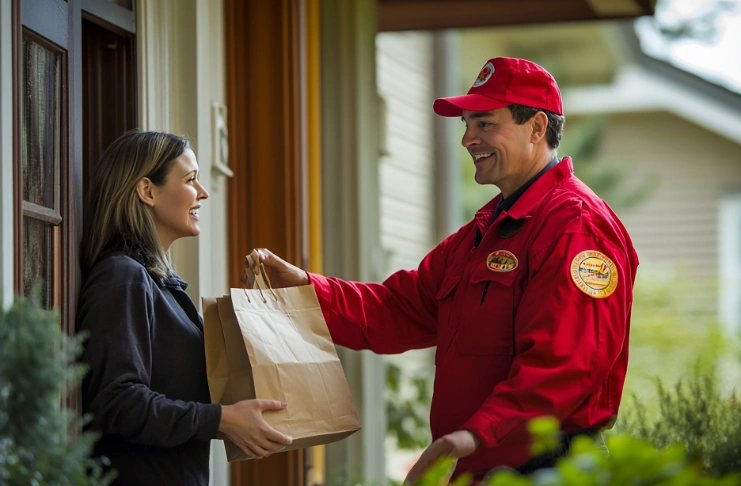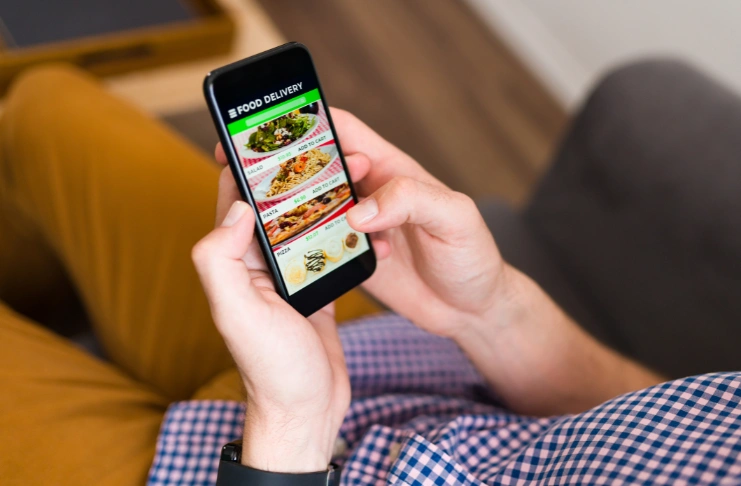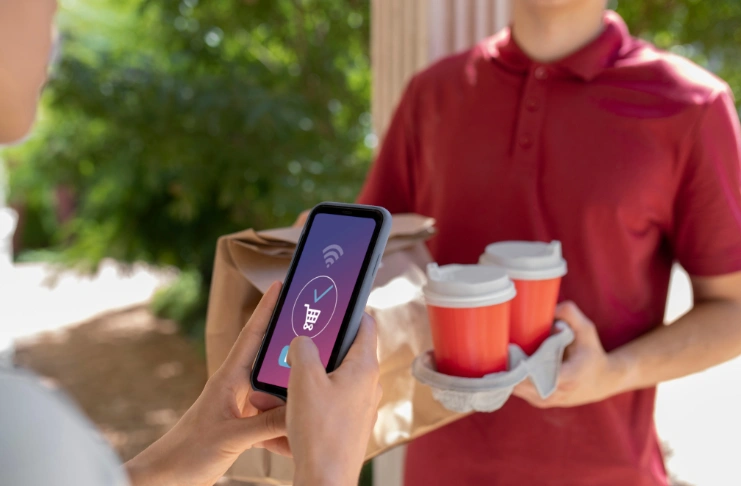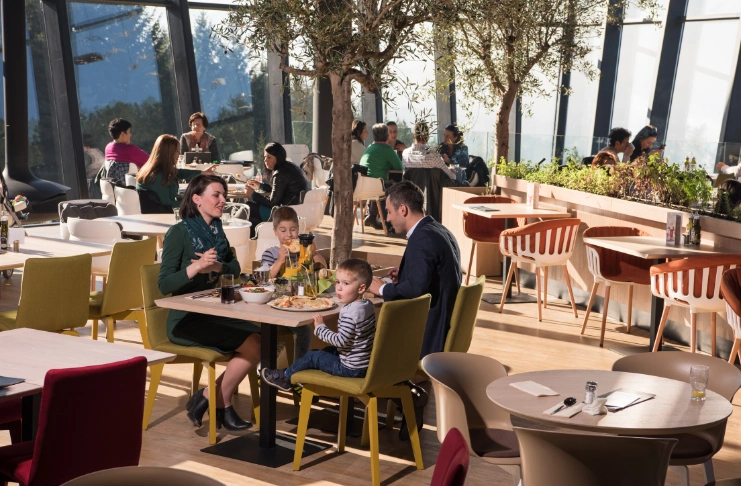
Delivery is rewriting the rules of customer expectations. They want access to their favorite meals without the friction of dine-in logistics, which means speed, reliability, and convenience are now non-negotiable, and diners judge your brand by how well you meet them.
For restaurants, this has changed the whole dining game. Many are rethinking how they approach operations, marketing, and menu strategies in order to reach customers beyond the dining room. At the same time, it has created new opportunities to connect with customers in ways that were previously impossible.
The Food Delivery Industry Landscape
Restaurant food delivery has always been an operational aspect of growing a restaurant. But the widespread use of smartphones and online food ordering systems has transformed how consumers access meals.
The convenience of browsing menus, placing orders digitally, and receiving food at home has reshaped dining habits and increased off-premise demand. By 2024, more than 60% of U.S. consumers were using delivery services at least once a week, and off-premise sales now represent roughly 11-30% of the total restaurant revenue.
This growth has been accelerated by the rise of third-party delivery services and apps. Platforms such as DoorDash, Uber Eats, and Grubhub provide the infrastructure that allows restaurants to reach customers beyond their physical locations without managing their own delivery fleets.
These services streamline ordering, offer real-time tracking, handle payments, and provide insights on customer preferences and peak demand patterns.
Role of Third-Party Delivery Services and Apps

Third-party delivery platforms have become integral to the modern food industry, serving as the bridge between restaurants and consumers. These platforms offer a comprehensive suite of services that streamline the ordering and delivery process, benefiting both restaurants and customers.
- Operational Efficiency: Third-party services handle the complexities of delivery logistics, including driver management, route optimization, and real-time tracking. This allows restaurants to focus on food preparation and in-house service without the added burden of managing a delivery fleet.
- Market Expansion: By partnering with established platforms like DoorDash, Uber Eats, and Grubhub, restaurants gain access to a vast customer base.
- Data Insights: These platforms provide restaurants with valuable analytics, such as customer preferences, peak order times, and geographic demand patterns. This data enables restaurants to make informed decisions about menu offerings, pricing strategies, and marketing efforts.
On the other hand, for customers, these platforms offer real-time tracking, seamless digital payments, and the ability to discover new restaurants without leaving their homes.
By allowing restaurants to scale off-premise operations efficiently, food ordering apps have become a critical component of the modern restaurant business model, shaping both how customers order and how restaurants operate.
Advantages of Food Delivery Service for Customers
As food delivery becomes a central part of modern dining, understanding why customers value it is critical for restaurants looking to optimize their offerings. The benefits go beyond simple convenience—delivery services shape consumer expectations, influence loyalty, and provide insights that restaurant owners can use to enhance satisfaction and repeat business.
Here’s why customers choose delivery services-
1. Convenience and Time-Savings
Time is one of the most significant factors driving delivery adoption. Customers increasingly seek meals that fit seamlessly into busy schedules without compromising quality. Delivery removes the need for commuting, waiting in lines, or preparing food at home, freeing time for work, family, or personal tasks.
Restaurants that simplify online menus, streamline ordering, and ensure fast, reliable delivery can directly enhance satisfaction. Plus, implementing platforms that offer easy reordering, saved preferences, and repeat-order options further reduce friction.
A customer who has had a positive experience on every visit trusts the restaurant more, positioning it as a dependable part of their routine. Over time, this trust translates into higher order frequency and sustained engagement.
2. Access to a Greater Food Variety
Food delivery apps provide customers with exposure to an extensive range of restaurants and cuisines that would otherwise require significant effort to access. From local favorites to global cuisines or trending offerings, consumers can experiment without leaving home.
To offer this, a strong digital presence and well-curated menu are critical for restaurants to stand out in a crowded ecosystem. Highlighting unique items, promotions, or chef specials can capture attention and encourage exploration.
This broader exposure benefits both parties: customers enjoy variety and discovery, while your restaurant reaches new audiences and increases its revenue potential.
3. Flexible Ordering and Payment Options
Modern delivery services accommodate multiple ordering methods, including apps, websites, and even voice-activated technologies. Customers can place orders anytime, from anywhere, which aligns with the 24/7 lifestyle many now expect.
At the same time, online food delivery websites and apps offer immense payment flexibility to customers. Customers can pay using digital wallets, credit/debit cards, or contactless options, which not only streamline transactions but also reduce the likelihood of abandoned orders.
Restaurants that integrate diverse payment solutions often see higher conversion rates and improved customer retention. Flexibility in both ordering and payment also improves the overall experience, reinforcing the perception that the restaurant is modern, responsive, and customer-focused.

4. Discounts and Loyalty Rewards
Promotions, bundled deals, and loyalty programs remain key motivators for using delivery services. Apps often highlight special offers, limited-time deals, or reward points that incentivize repeated orders and larger basket sizes.
You can also start your own loyalty initiatives within delivery platforms to enhance engagement while generating valuable behavioral data. Plus, tracking customer orders, preferences, and redemption patterns will also help you to refine marketing campaigns and menu offerings, creating a cycle of continual improvement.
5. Accessibility for Diverse Needs
Delivery expands accessibility for customers who may face mobility challenges, time constraints, or health-related limitations. It also caters to dietary preferences and restrictions, allowing users to filter menus based on allergies, nutrition, or lifestyle choices.
It is also important to clearly communicate dietary options, ingredient lists, and customization possibilities to capture segments that might otherwise be excluded. This inclusivity not only demonstrates social responsibility but also drives repeat business from a broader audience.
By supporting diverse needs, restaurants make their offerings more relevant and convenient, increasing both reach and customer satisfaction.
6. Real-Time Order Tracking
Transparency is a growing expectation in the delivery experience. Real-time tracking allows customers to see when their meal is being prepared, picked up, and en route, reducing uncertainty and frustration.
To offer a seamless tracking experience, maintain accurate ETAs, update customers proactively, and address delays quickly to prevent complaints and improve overall satisfaction. Tracking features also reinforce brand reliability and trust, signaling that the restaurant values the customer’s time and experience.
INDUSTRY INSIGHT
In 2025, user penetration in the U.S. restaurant delivery market is 43.2%, expected to increase to ~45.6% by 2030. What’s more, the average delivery order value is $36.20, which is almost double the typical $18.20 pickup order and around 25% higher than dine-in sales. This trend highlights both the convenience customers seek and the revenue boost restaurants gain.
Advantages of Food Delivery Services for Restaurants
1. Expand Reach Beyond Physical Location
One of the most immediate benefits of online food delivery apps is the ability to reach customers outside the restaurant’s immediate vicinity. Traditional dine-in traffic is limited by geography, but delivery platforms provide exposure to neighborhoods and demographics that might never have visited the physical location.
Third-party apps, with millions of active users, act as a digital marketplace, putting restaurants in front of a broad audience instantly. This access allows smaller or newer establishments to compete with larger, established brands without significant marketing investment.
Expanding reach also enables restaurants to test new areas and target different customer segments. You can easily analyze order patterns, identify high-demand zones, and adjust menus or promotions accordingly, turning delivery into both a growth and market intelligence tool.
2. Higher Check Sizes and Order Volumes
Delivery services often drive larger orders compared to typical dine-in experiences. Customers tend to bundle meals, add sides, or take advantage of bundle deals and family-style options available on apps.
This makes it important for your restaurant to strategically design menu options specifically for delivery, such as combos or add-ons, which encourage higher check sizes. Additionally, delivery orders frequently come from repeat customers, increasing order frequency and overall volume.
3. Boost Customer Loyalty with Promotions and Deals
Restaurants can highlight limited-time offers, bundle deals, and rewards programs directly within the app, influencing customer behavior at the point of decision.
These programs incentivize repeat orders and allow operators to experiment with marketing strategies at a low cost. Tracking redemptions and customer engagement provides actionable insights into what resonates with specific segments.
When integrated thoughtfully, promotions and loyalty programs strengthen brand attachment. Customers are more likely to choose a restaurant that consistently rewards repeat business, building sustainable engagement over time.
4. Gain access to Customer Data and Insights
One of the less obvious, but highly valuable, advantages of food delivery app is access to customer data. When integrated with your POS system, you can receive insights into ordering patterns, peak hours, popular dishes, and even geographic demand clusters.
This data allows operators to make informed decisions about menu offerings, staffing, inventory, and targeted promotions. For example, identifying high-demand items can guide preparation and inventory levels, reducing waste and improving efficiency.
Delivery data also informs marketing campaigns. You can segment customers by preferences or order frequency, creating personalized offers that improve retention and conversion. Strategic use of this intelligence transforms delivery from a transactional service into a growth and planning tool.
5. Ensure Stronger Brand Visibility
Being listed on popular delivery apps provides immediate brand exposure to a large user base. Even customers unfamiliar with the restaurant can discover it while browsing through the platform’s recommendations, top picks, or search results.
Enhanced visibility is particularly valuable for newer or smaller restaurants competing in saturated markets. This is where consistent branding within app listings—through images, menu descriptions, and promotions—also plays a key role in reinforcing the restaurant’s identity and building recognition.

6. Opportunities with Cloud/Virtual
Delivery platforms have prompted the growth of cloud or virtual kitchens, which operate without a traditional storefront. Restaurants can test new concepts, launch additional brands, or expand menus solely for delivery, minimizing real estate costs and operational risks.
This model allows operators to reach multiple market segments from a single kitchen location, optimizing labor and supply costs. You also get the flexibility to experiment with cuisines or seasonal offerings with minimal financial exposure, leveraging delivery demand to validate concepts before scaling.
Cloud kitchens also allow for flexible adjustments based on order volume or customer preferences, creating a more agile business model that can adapt quickly to market trends.
7. Business Resilience During Disruptions
Delivery services strengthen resilience against market disruptions, such as inclement weather, local events, or public health restrictions, during periods when dine-in traffic declines, delivery provides a steady revenue channel, mitigating financial risk.
The COVID-19 pandemic demonstrated the critical role of off-premise channels in sustaining restaurants. Operators with established delivery capabilities were able to maintain operations and retain customer engagement, while those without delivery infrastructure struggled to survive.
Beyond emergencies, ongoing reliance on delivery provides operational flexibility. Restaurants can manage inventory, staffing, and menu options dynamically, responding to demand fluctuations without the constraints of dine-in capacity.
Things to Consider Before Offering Delivery Services
Integrating delivery into your restaurant’s operations requires careful evaluation because it involves aligning this channel with your restaurant’s capabilities, customer expectations, and operational strengths.
Here are some factors to consider when deciding whether delivery is the right move for your establishment.
A. Restaurant Type
Your restaurant’s concept and operational model play a crucial role in determining the feasibility and success of offering delivery.
- Full-Service Restaurants: These establishments often have complex menus and require significant preparation time. Offering delivery can be challenging due to the need to maintain food quality during transit and the potential strain on kitchen resources. Additionally, managing delivery logistics can divert attention from in-house dining services.
- Quick-Service Restaurants: QSRs with streamlined menus and faster preparation times are generally better suited for delivery services. Their operational efficiency allows for quicker turnaround times, which is essential for maintaining food quality and customer satisfaction during delivery.
- Virtual Kitchens: These delivery-only models operate without a physical storefront, focusing solely on fulfilling online orders. They can be highly efficient and cost-effective, as they eliminate the overhead associated with dine-in services. However, their success often depends on strong online marketing and consistent quality to attract and retain customers.
Understanding your restaurant type helps in assessing the operational adjustments and investments needed to implement a successful delivery service.
B. Reliance on Third-Party Delivery Apps
Partnering with third-party delivery platforms like DoorDash, Uber Eats, or Grubhub can expand your customer reach but comes with considerations. These platforms provide access to a large customer base, reducing the need for extensive marketing efforts. They handle logistics, allowing your staff to focus on food preparation.
However, what you must consider is that third-party delivery services typically charge commission fees, which can range from 15% to 30% per order. This can significantly impact profit margins. Additionally, reliance on these platforms means less control over customer interactions and potential brand dilution.
So, it’s essential to weigh the benefits of increased exposure against the costs and potential loss of brand identity when deciding on third-party partnerships.
C. Location and Logistics
Your restaurant’s location and the surrounding infrastructure are pivotal in determining the success of a delivery service. Restaurants situated in densely populated urban centers can benefit from a higher volume of delivery orders.
However, they may also face challenges such as traffic congestion and parking difficulties, which can delay deliveries and affect customer satisfaction.
On the contrary, smaller areas may have less traffic congestion, but the lower population density can mean limited access and fewer delivery orders. Additionally, longer delivery distances can increase operational costs and delivery times.
As a result, effective logistics planning is crucial. This includes optimizing delivery routes, ensuring timely deliveries, and maintaining food quality during transit. Investing in reliable delivery management systems can help streamline operations and improve efficiency.
D. Customer Preferences
Before even considering implementing a delivery service for your restaurant, think about whether they would even use it. Your customers’ preferences are vital in tailoring your delivery service to meet their expectations.
- Surveying Customers: Conduct surveys or engage with customers through social media to gauge interest in delivery services. Understanding their preferences can help in menu planning, pricing strategies, and promotional efforts.
- Analyzing Competitors: Study competitors offering delivery services to identify best practices and potential gaps in the market. This can provide insights into customer expectations and help differentiate your service.
- Feedback Mechanisms: Implementing a system for collecting and analyzing customer feedback can help in continuously improving the delivery experience. Addressing concerns promptly and making necessary adjustments can enhance customer satisfaction and loyalty.
By aligning your delivery service with customer preferences, you can increase the likelihood of success and build a loyal customer base.
Conclusion
As delivery continues to reshape dining habits, restaurants that embrace it thoughtfully can uncover opportunities in menu innovation, strategic partnerships, and customer engagement models that weren’t possible before. At the same time, customers benefit from more choice, flexibility, and accessibility, creating a dynamic interplay that drives the industry forward.
Understanding delivery as a means of experimentation and expansion allows restaurants to anticipate trends, refine offerings, and build resilience, making it a cornerstone for sustainable growth in a fast-evolving market.
Frequently Asked Questions
Food delivery services expand a restaurant’s reach, increase revenue opportunities, and provide convenience to customers. They provide access to data and marketing insights while supporting brand visibility. However, they can reduce profit margins due to commission fees, add operational complexity, and risk quality control during transit, requiring careful planning to maintain customer satisfaction.
Meal delivery services offer convenience, variety, and time savings for consumers while giving restaurants access to a wider customer base and promotional opportunities. On the downside, high platform fees, reliance on third-party logistics, and potential brand dilution can impact margins and customer experience.
The main advantage of fast food deliveries is convenience. Customers can quickly access meals without leaving home, saving time and effort. For restaurants, delivery drives higher order volume, supports upselling through bundled meals or add-ons, and strengthens engagement with time-sensitive, convenience-oriented customers who prioritize speed and accessibility over dine-in experiences.
DoorDash provides restaurants with a large built-in customer base, digital storefront, and streamlined logistics for delivery operations. It offers marketing tools, real-time order tracking, and data insights to optimize menu offerings and promotions. While it levies certain commission fees, the platform allows restaurants to expand reach, increase orders, and build brand visibility without significant upfront investment.








